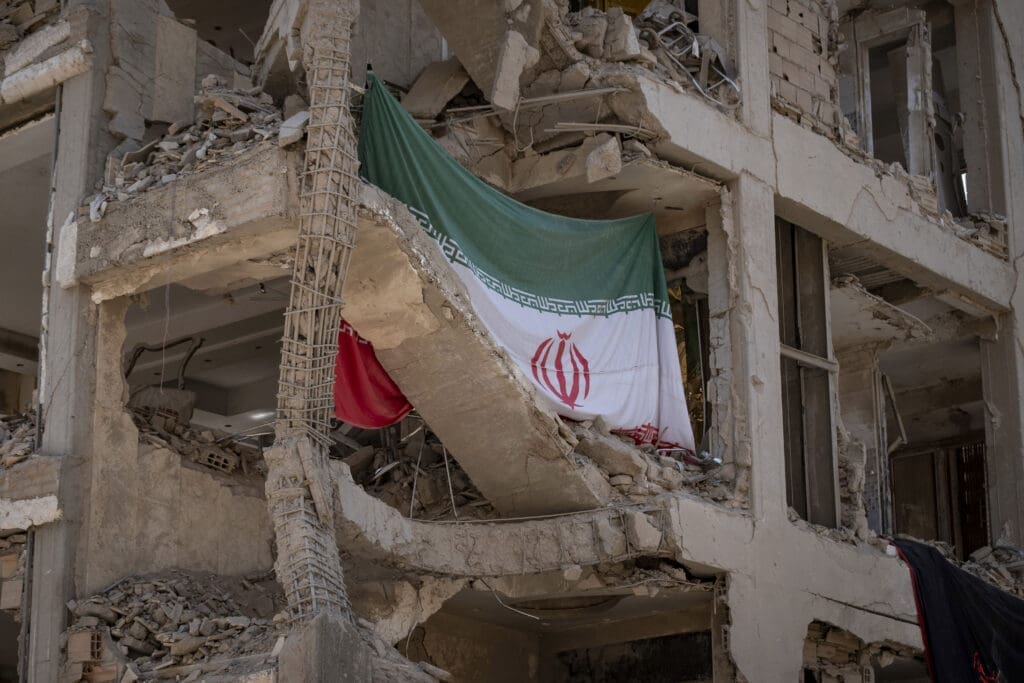Since Israel’s 12-day war with Iran came to an end last June, the prospect of a return to fighting has loomed large, primarily because Israel has yet to achieve all of its goals vis-a-vis Iran and may be determined to do so. Though the war was likely driven by more than one consideration, Israel’s overarching strategic objective was solitary: permanently neutralizing Iran’s capacity to meaningfully challenge Israeli regional dominance. A range of desirable scenarios were seen as satisfying this grand vision: complete state collapse and territorial fragmentation; installation of a new political system more compliant with Israeli interests; the irreversible defanging of Iran’s military power, leaving it comprehensively defenseless in case of future Israeli attacks—just as Syria and Lebanon are today.
The Road to Success
In line with this grand vision, Israel’s war sought to create two interlocking pathways to victory.
The first pathway would soften Iran from within, precipitating state collapse through cascading institutional failures and widespread social unrest directed at the state. This began with a grisly decapitation campaign targeting Iran’s military and political leadership, nuclear scientists and their families. It then escalated into a full-frontal assault on nuclear installations as well as state institutions such as the armed forces, police stations, state broadcaster, prisons, critical energy infrastructure, universities, hospitals and social services.
But beyond devastating critical infrastructure, a core pillar of Israel’s efforts to cripple the state and unravel its cohesion was—almost excessively so—psychological. It sought to create an overwhelming impression of Israeli omnipotence on the one hand and Iranian impotence on the other.
For instance, to cause widespread fear, panic, and displacement, evacuation orders were issued to hundreds of thousands of Iranian citizens, warning them to leave their own neighborhoods ahead of airstrikes. To generate nationwide economic anxiety, Israel used cyberattacks to obstruct salary payments to Iranians waiting for their monthly wages. The goal here was to convert the public’s latent—and newly inflamed—despair, discontent and fear, into active, and ideally violent, opposition to the leaders, symbols and institutions of the state—an outcome that never materialized.
The second pathway, which would build directly on the success of the first, aimed to irreversibly lock Washington into a direct, extensive and sustained military confrontation with Tehran. Without this escalation, Israel’s campaign risked being remembered as a spectacular raid rather than a decisive, epoch-defining war such as the Six-Day War in 1967. To ensure direct American military involvement, Israel needed to manufacture the perception of a war ready to be won by a swift, low-risk and high-reward American military nudge that would complete the internal collapse set in motion by the first pathway. Only then would Trump, mindful of his political base’s strong aversion to protracted and costly military quagmires, consider engaging U.S. forces inside Iran.
And sure enough, Israel appeared breathtakingly close to reaching this coveted goal in the opening stages of its ambitious blitz. The depth of Israel’s intelligence penetration, its systematic elimination of Iran’s top military brass and nuclear scientists, its devastating air strikes on nuclear facilities, the suppression of Iranian air defenses; and Iran’s apparent difficulty in mounting swift and effective retaliation all prompted a watchful Washington to wonder whether Iran was on the brink of total collapse. As evinced by America’s eventual bombing of Iran’s nuclear installations towards the end of the war, Israel did succeed in escalating Washington’s role from a generous enabler to that of a combatant operating directly on Iranian soil.
Misreading Iran
At first glance, Israel’s war on Iran can read like a success story, as it managed to establish unprecedented intelligence penetrations and operational capabilities deep inside Iranian territory, systematically eliminating top military commanders and nuclear scientists while carrying out sabotage operations across the country. Iran’s air defenses and its ability to retaliate were severely suppressed in the early hours of the war, while the country’s nuclear program suffered serious damage. Perhaps most significantly, Israel succeeded in creating the conditions for the U.S. to carry out its first-ever overt and large-scale bombing of Iran. Yet, these significant tactical successes notwithstanding, the war may ultimately have sown the seeds of its own strategic undoing.
A strategically ruinous pillar of Israel’s war was the firmly held, yet cartoonish, belief that in the midst of a fully-fledged war on their country, millions of Iranian citizens would, prioritize domestic grievances over national survival, transforming themselves into willing instruments of their country’s dismemberment. Predictably, Iranians did not rise en masse to voluntarily realize Israel’s strategic vision for their country. What did unfold, however, was a surge of nationwide grassroots solidarity ignited by Israel’s frontal assault on key pillars of nationhood, civilian infrastructure, and the public’s sense of security. This collective national energy formed a cornerstone, if not the cornerstone, of Iran’s national resilience during the war, which, combined with Iran’s precise ballistic missile counterstrikes, played a pivotal role in jamming the carefully-crafted machinery of Israel’s blitzkrieg.
Whether this groundswell of national unity will lead to lasting democratic reforms within Iran remains to be seen. What is far more certain, however, is that in the event of another round of Israel-Iran military showdown in the near term, Iranian leaders should be able to tap into a vast reservoir of national resilience laid bare by none other than Israeli leaders themselves.
In the longer term, too, the war has set the stage for a seismic recalibration in Iranian national security consciousness. The national trauma of the 1980s Iran–Iraq war had for decades been the singular historical event most profoundly responsible for both shaping and justifying Iran’s security doctrine, though the durability of that resonance—particularly among younger generations who know the war only indirectly—remains difficult to gauge. However, the visceral, collective experience of witnessing yet another war waged by powerful militaries within Iran’s borders has once again elevated national defense to a tangible existential imperative in the popular imagination. Ordinary Iranians, many of whom were born decades after the war with Saddam’s Iraq, saw firsthand the ease with which Israel sliced through their country’s air defenses. But they also witnessed how Iran’s ballistic missiles proved decisive in blunting Israel’s campaign and shifting the tide of war in Iran’s favor. The predictable upshot has been an increase in public support for shoring up Iran’s air defenses, modernizing its dilapidated fleet of ageing aircraft and expanding the missile program, which has traditionally enjoyed widespread support amongst ordinary Iranians.
But the war has also altered how the nation perceives security threats. For the first time in decades, Israel and the United States are squarely within the crosshairs of a much broader spectrum of ordinary Iranians. Hobbled by persistent crises of governance and legitimacy, Iran’s ruling elites had, over the years, found it increasingly difficult to convince a non-negligible portion of the populace that Israel and the U.S. constituted existential threats to the country’s national security. Cognizant of this chasm, the Islamic Republic’s adversaries had for decades relied on a carefully-cultivated distinction between the Iranian people and the Iranian regime, a framing that found a receptive audience of Iranians who viewed the U.S. and Israel as distant, abstract or even ambivalent entities. The recent war has demonstrated, however, that the U.S. and Israel have both the capacity and willingness to harm not only the ever-elusive “regime” but also ordinary Iranians.
Lastly, the war, although succeeding in creating the conditions for a limited American military strike on Iran, may eventually erode Israel’s long-term strategic posture vis-à-vis Iran by facilitating the latter’s march towards nuclear ambiguity. In addition to prompting Iran to sharply curtail its cooperation with the IAEA—leaving Israel further in the dark about Iran’s nuclear activities—the strikes have, according to MIT professor Theodore Postol, catapulted Iran to the status of an “undeclared nuclear weapons state.” Iran’s stockpiles of highly enriched uranium, which only Iranian authorities can locate with absolute certitude, position the country just one technical step away from weapons-grade material, while providing the strategic benefits of nuclear ambiguity—the same posture Israel has maintained for decades. But if Iran now truly is an undeclared nuclear weapons state, it has attained this status without the diplomatic costs of open testing or formal weapons declarations, although this ambiguity could prove short-lived should Israel and the United States opt for a prolonged and large-scale campaign to locate and destroy Iran’s stockpiles and enrichment facilities
Paradoxically, this outcome was made possible by Israel’s own decision to launch a war it has yet to complete. Reflecting their shortcomings in June, one cannot help but wonder if the Israelis do not know Iran as well as they might think. As the region braces for the prospect of another round of war between Israel and Iran, the question to answer is whether Israeli leaders have learned from the mistakes of the first round—or are destined to repeat them.
The opinions expressed in this article are those of the author and do not necessarily reflect the views of the Middle East Council on Global Affairs.


